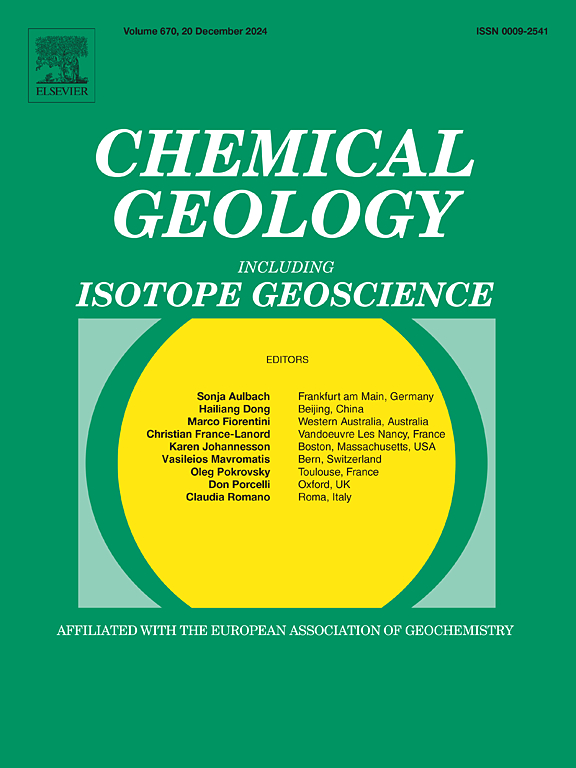Linking the oxygen-17 compositions of water and carbonate reference materials using infrared absorption spectroscopy of carbon dioxide
IF 3.6
2区 地球科学
Q1 GEOCHEMISTRY & GEOPHYSICS
引用次数: 0
Abstract
Joint measurements of the 18O/16O and 17O/16O ratios of carbonate minerals and waters are increasingly used to investigate various geochemical, physical and biological processes. Diverse analytical methods, each of them technically challenging in one way or another, have been developed or refined in recent years to measure oxygen-17 anomalies (Δ’17O) with instrumental precisions of 10 ppm or better. A critical underpinning of all these methods is how the international carbonate reference materials currently anchoring the VPDB 18O/16O scale are linked to the primary VSMOW-SLAP scale in (18O/16O, 17O/16O) space. For now, however, substantial systematic discrepancies persist between different groups and methods, even after all measurements are nominally standardized to VSMOW-SLAP.
Here we take advantage of VCOF-CRDS, a novel spectroscopic method combining the ease and simplicity of near-infra-red absorption measurements in pure CO2 with metrological performance competitive with state-of-the-art IRMS techniques, to precisely characterize, based on previously reported equilibrium fractionation factors between water and CO2, the relative triple oxygen isotope compositions of international water standards (VSMOW2, SLAP2, GRESP) and CO2 produced by phosphoric acid reaction of carbonate standards (NBS18, NBS19, IAEA603, IAEA610, IAEA611, IAEA612). The robustness of our results derives from the demonstrated linearity of our measurements (RMSE ≈ 1 ppm), but also from the fact that, when equilibrated with or converted to CO2, all of these reference materials yield analytes with closely comparable oxygen-18 compositions. In light of these observations, we revisit potential causes of the large inter-laboratory discrepancies reported so far. Collectively reconciling the different types of measurements constraining the relative 17O/16O ratios of the two standards most often used to normalize carbonate analyses (NBS18, IAEA603) is a matter of high priority.
利用二氧化碳的红外吸收光谱连接水和碳酸盐对照物的氧-17组成
碳酸盐岩矿物和水体的18O/16O和17O/16O比值的联合测量越来越多地用于研究各种地球化学、物理和生物过程。近年来,已经开发或改进了各种分析方法,每种方法在技术上都具有一定的挑战性,以测量氧-17异常(Δ ' 17O),仪器精度为10ppm或更高。所有这些方法的关键基础是如何将目前锚定VPDB 18O/16O标度的国际碳酸盐参考物质与(18O/16O, 17O/16O)空间的主要VSMOW-SLAP标度联系起来。然而,就目前而言,即使在所有测量都被名义上标准化为VSMOW-SLAP之后,不同的小组和方法之间仍然存在实质性的系统差异。
本文章由计算机程序翻译,如有差异,请以英文原文为准。
求助全文
约1分钟内获得全文
求助全文
来源期刊

Chemical Geology
地学-地球化学与地球物理
CiteScore
7.20
自引率
10.30%
发文量
374
审稿时长
3.6 months
期刊介绍:
Chemical Geology is an international journal that publishes original research papers on isotopic and elemental geochemistry, geochronology and cosmochemistry.
The Journal focuses on chemical processes in igneous, metamorphic, and sedimentary petrology, low- and high-temperature aqueous solutions, biogeochemistry, the environment and cosmochemistry.
Papers that are field, experimentally, or computationally based are appropriate if they are of broad international interest. The Journal generally does not publish papers that are primarily of regional or local interest, or which are primarily focused on remediation and applied geochemistry.
The Journal also welcomes innovative papers dealing with significant analytical advances that are of wide interest in the community and extend significantly beyond the scope of what would be included in the methods section of a standard research paper.
 求助内容:
求助内容: 应助结果提醒方式:
应助结果提醒方式:


